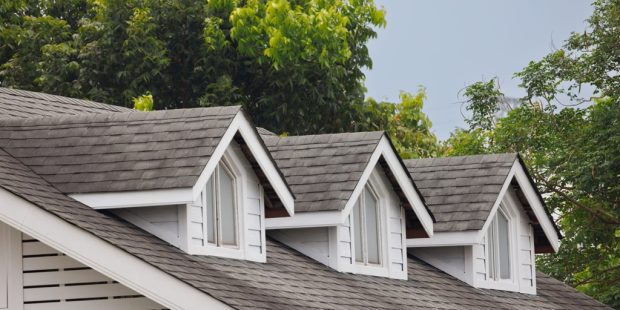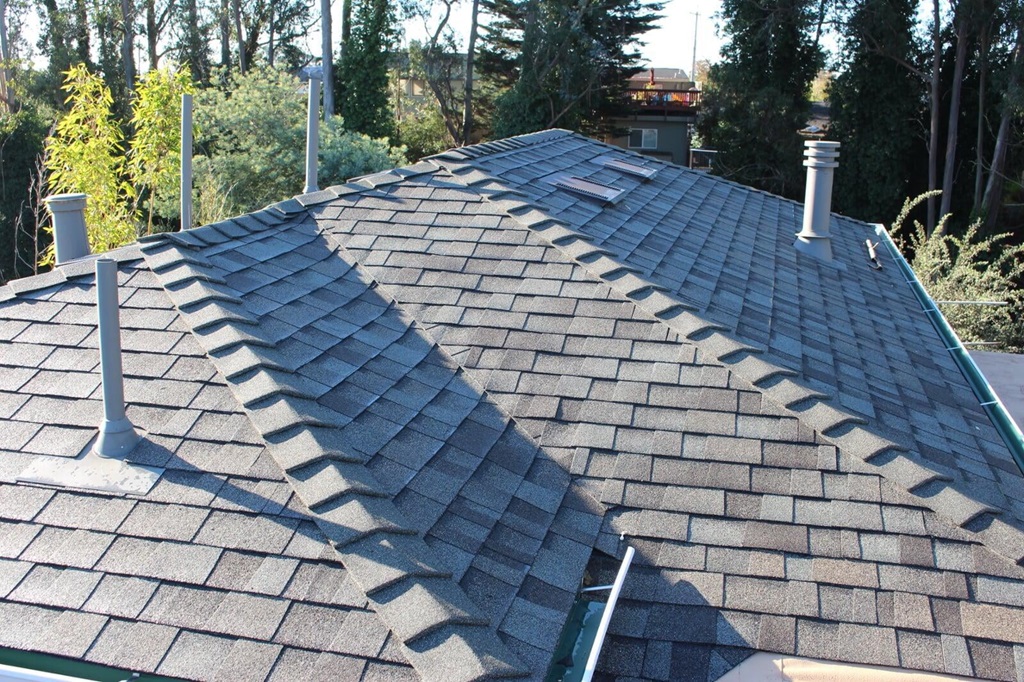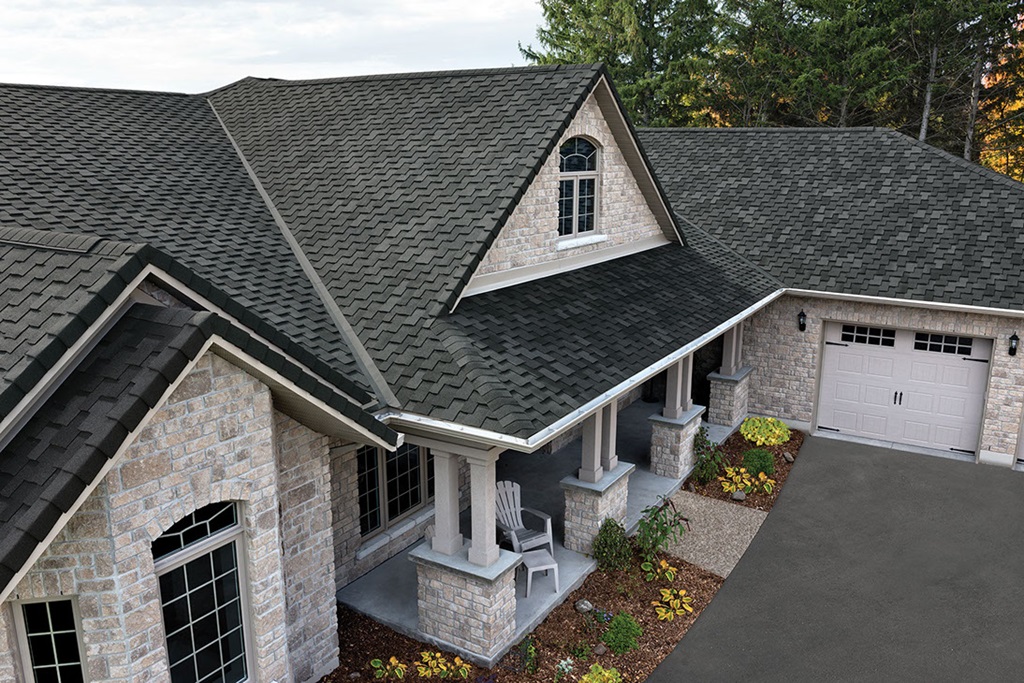
Composition shingle roofing is a popular choice among homeowners who are looking for a new roof. It is a significant investment in a home, but it offers excellent performance, durability, and affordability. Many homeowners choose composition shingles as they are one of the most popular roofing materials on the market today.
This comprehensive guide will give you everything you need about composition shingle roofing. We’ll discuss what composition shingles are, the advantages and disadvantages of this roofing material, how long they typically last, what factors impact their lifespan, and what to look for when hiring a professional roofer to install or replace your composition shingle roof. Let’s start with the basics.
What Are Composition Shingles?
Composition or asphalt shingles are made from a fiberglass mat or organic felt coated with asphalt and topped with ceramic granules. The asphalt provides waterproofing, while the fiberglass mat or felt gives the shingle strength and stability. The ceramic granules protect the asphalt from UV rays and offer color options.
These shingles are one of the most affordable and versatile roofing materials. They come in various styles and colors, allowing homeowners to customize the look of their roofs. Composition shingles are also lightweight and easy to install, making them popular with many contractors.
How Are Composition Shingles Made?
Composition shingles go through a complex manufacturing process to achieve their layered design.
Here are the basic steps:
- The base material, usually a fiberglass mat or organic felt, is coated with asphalt on both sides. The asphalt acts as a waterproofing agent.
- The first ceramic granular layer is embedded into the still-hot asphalt on one side of the shingle. This layer of granules provides UV protection and gives the base color.
- The shingle is coated with additional asphalt and a second layer of granules on the other side. This double layer creates the dimensional or architectural look of the shingle.
- Additional options like reflective granules or adhesive sealant strips can be added to the shingle. The shingles are cut into individual pieces.
- The finished shingles are bundled and packaged for shipping to suppliers and roofing contractors.
The Pros and Cons of Composition Shingles
Composition shingle roofing offers many benefits for homeowners. But there are a few potential downsides to consider as well. Let’s look at the key pros and cons.
Pros
Affordability: Composition shingles are one of the most budget-friendly roofing options. They provide an asphalt shingle roof at a lower cost than premium materials like slate or metal roofing.
Versatility: With a wide range of color and style options, it’s easy to get the ideal look with composition shingles. They can complement styles from traditional to modern.
Durability: Modern laminated composition shingles are designed to withstand exposure, heat, and impact. They are correctly installed and hold up well to wind, rain, snow, and hail.
Low Maintenance: Aside from occasional cleaning and inspections, composition shingle roofs require less ongoing maintenance than other materials.
Energy Efficiency: Newer color options include reflective granules to reduce heat absorption. This can lower air conditioning costs.
Easy Installation: Composition shingles are lightweight and straightforward to install. Repairs can also be done quickly by experienced roofers.
Cons
Shorter Lifespan: The average lifespan is 20-25 years. Premium or thicker shingles may last 30 years or longer, but this is still less than other roofing types.
Potential Leaks: Improper installation, aging, and curling shingles can lead to possible leak points. Annual inspections help detect damage early.
Susceptible to Damage: Hail, falling branches, and foot traffic can more easily damage composition shingles than other materials like metal or slate.
Lower Resale Value: Composition shingle roofs may not increase resale value as much as other premium or long-lasting roof types.
Not Environmentally Friendly: The asphalt composition and manufacturing process make them less eco-friendly than other green roofing options.
How Long Do Composition Shingles Last?
The typical lifespan for composition shingles is 20-25 years.
However, many factors impact how long they will last:
- Quality of Materials: Higher-quality thick shingles with heavier asphalt and ceramic coating will last longer than cheaper options.
- Roof Slope: Steeper roofs allow shingles to shed water, leaves, and debris more quickly. Flatter roofs mean more wear and tear.
- Installation Quality: Proper installation according to the manufacturer’s guidelines is essential for the entire lifespan.
- Climate: Hotter and humid climates cause faster wear from heat and expansion/contraction. Cold climates can damage shingles from frost and ice dams.
- Ventilation: Good attic ventilation regulates temperature and moisture, preventing early deterioration.
- Weather Exposure: Hail, strong winds, storms, and fallen debris take a toll on any roof. However, composition shingles are more easily damaged than other materials.
- Foot Traffic: Regular foot traffic for repairs, cleaning, or installing appliances or vents will wear down spots faster. Use boards to walk on the roof.
- Color Choice: Darker shingle colors absorb more heat from the sun, expanding and contracting more drastically. This leads to cracking and curling.
- Direction Face: South/west-facing roofs endure more sun exposure and heat during the day, shortening their lifespan.
With proper installation and care, most standard composition shingle roofs will last 20-25 years under normal conditions. Higher-quality options may reach 30 years or more. But ultimately, regional climate, maintenance, and exposure play pivotal roles.
When To Replace Your Composition Roof
Knowing when to replace your aging composition shingle roof is essential. Waiting too long risks expensive interior water damage from leaks. But replacing it too early wastes money from years of life left on the roof.
Watch for these key warning signs that indicate it’s time for a new composition shingle roof:
- Curling or buckling shingles: Heat causes the edges and corners to lift or curl up visibly. These openings are prone to wind damage and leaks.
- Cracking or broken granule coating: The ceramic granule coating protects the asphalt shingle base. Once cracks form, exposing the asphalt, UV rays deteriorate it faster.
- Bald spots or missing shingles: Storm damage or age can lead to lost shingles. The exposed areas that remain are vulnerable points to water intrusion.
- Leaking interior ceiling stains: Once leaks form, it’s only a matter of time until water intrudes through the attic into living spaces. Stains indicate existing damage.
- Excessive cooling costs: Heat leaking from a worn roof can spike AC bills in summer. This signals poor insulation and energy efficiency.
- Moss or algae growth: Consistent dampness from shedding issues or pooling water allows moss and algae to grow, worsening wear.
- Age over 25 years: Even without other visible issues, it’s risky to go past 25 years. The older the shingle, the more likely problems will develop.
Ideally, schedule professional inspections every 2-3 years once your roof passes ten years. This allows early detection and repair of minor problems before they mushroom into significant leaks or replacement needs.
What to Look for When Hiring a Roofer
Finding an experienced, reputable roofing contractor is as important as choosing the right shingle.
Here are the top factors to look for:
- Local company: Hire a contractor in your area, not someone just passing through. They understand the regional climate impact on roofs.
- Industry credentials: Look for licenses, manufacturer certifications, and associations like NRCA membership. This ensures proper training.
- Experienced with composition shingles: Find a roofer with extensive knowledge, specifically installing and working with composition shingles.
- Permanent business location: Avoid “fly-by-night” operations without a longstanding local business address and facility. These disappear quickly when issues arise.
- Liability insurance and bonded: Make sure the company carries adequate general liability insurance and any required bonding. This protects you from liability.
- Warranty on work: Quality companies will stand behind their work and materials with a warranty. Typically, this covers defects for 1-5 years or more.
- References and reviews: Ask for multiple local references and online reviews. This helps validate the quality and reliability of their roofing work.
- Detailed inspection and quote: The quote should outline the inspection findings, recommended repairs, products, work scope, and specifications.
By selecting the right roofing contractor, you ensure expert installation and peace of mind that your new shingle roof will have maximum durability. Be wary of quotes that seem too good to be true – cheap labor and materials usually translate to poor quality and shortcuts.
New Roof Installation Process
Replacing a composition shingle roof is a significant project that requires careful planning and execution.
Here is an overview of the key stages:
Tear-Off the Old Roof: The old shingles and underlayment are removed from the bare roof deck. This allows inspection for any rot or structural issues.
Roof Deck Repairs: Any damaged or warped roof deck sections are repaired or replaced to create a smooth, even surface.
Leak Barriers Laid: Leak barriers like roofing felt, ice, and water shields are installed. This provides a protective layer over the roof deck.
Drip Edge Installed: A metal drip edge is placed around the perimeter and eaves. This channels water off the edges rather than seeping under.
Underlayment Added: A secondary layer of synthetic underlayment or felt paper is rolled out over the entire roof.
Ventilation Checked: Existing vents are checked to ensure proper airflow. New vents may be added if inadequate ventilation exists.
Starter Shingles Laid: Starter shingles are installed along the eaves and edges. This prepares a base for the finished shingles.
Composition Shingles Installed: The new composition shingles are installed row by row up the roof and fastened. A proper nailing pattern ensures stability.
Flashing Around Protrusions: Weather-tight flashing surrounds chimneys, vent pipes, and skylights. This prevents leakage points.
Ridge Caps Added: To cover and reinforce these high points, ridge venting and ridge cap shingles are installed along peak ridges.
Clean Up: The roof and property are cleaned up thoroughly when finished. Nails and debris are cleared away.
A complete tear-off and replacement allow for assessing and remedying any issues with the roof deck, ventilation, flashing, and upkeep. This gives your new roof the best condition to achieve its maximum lifespan.
Roof Ventilation Needs
Proper attic ventilation improves air circulation under your roof. This regulates temperature and removes moisture that can damage shingles and lead to mold.
The optimal ventilation area equals 1 square foot for each 150 square feet of attic space. This is achieved through a balance of intake vents at the roof edge and exhaust vents at or near the ridge.
Standard intake ventilation options include:
- Soffit vents
- Under eave vents
- Gable end vents
Standard exhaust ventilation options include:
- Ridge vents
- Roof vent stacks
- Power attic fans
If your existing roof lacks sufficient or balanced ventilation, it’s a good idea to address this during roof replacement. Your contractor can assess and make recommendations for any needed upgrades or additions.
Proper ventilation extends the life of your shingles and preserves your wood roof decking. Make sure to maintain precise airflow by regular cleaning around vent openings.
Conclusion
There are many good reasons composition shingles are such a popular roofing choice for homeowners. When properly installed and maintained, they offer affordability, curb appeal, and reliability. While hail, storms, and age will eventually require replacement, you can maximize the lifespan of your composition roof by choosing quality materials and hiring experienced local roofers.
With routine inspections, good ventilation, care, and upkeep, your composition shingle roof will protect your most valuable asset for 20-25 years. Use this guide to make informed decisions when investing in a new composition roof. With the correct information and preparation, you’ll have a durable, attractive roof you can enjoy for decades.
FAQ About Composition Shingle Roofs
Here are answers to some of the most frequently asked questions about composition shingle roofs:
What are the most popular colors and styles?
Black, grey, brown, and terracotta tones are popular neutral colors that complement most home styles. Architectural styles like dimensional and laminated shingles offer more depth and curb appeal.
How much does a new composition shingle roof cost?
The average cost to install a new composition shingle roof is $6,000-$12,000, depending on the roof size, materials, and labor. Simple one-layer tear-offs on smaller roofs fall at the lower end.
How long after installation can I walk on my new roof?
It’s best to allow the shingle seal strips to fully adhere for at least 48-72 hours after installation before walking on the roof. After that, limit foot traffic and always wear soft-soled shoes.
Should I clean my composition shingle roof regularly?
Occasional low-pressure washing to remove moss, mildew, and excess debris is delicate. But avoid pressure-washing, harsh chemicals, or regular scrubbing that can damage shingles.
How can I tell if my roof has hail damage?
Signs of hail damage include bruises, minor cuts, tears, or holes in the shingles. Granule loss exposing the mat surface is also a red flag for impact damage.


